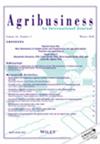乌拉圭肉牛生产的技术前沿:技术效率及其主要驱动因素分析
IF 2.1
3区 经济学
Q2 AGRICULTURAL ECONOMICS & POLICY
引用次数: 0
摘要
在全球范围内,牲畜放牧是土地的主要占用者,并经常因其对环境的影响而受到批评。为了解决这些问题,提高牲畜生产率对于减轻这些影响、提高农场竞争力和增加粮食产量至关重要。了解生产的可变性是实现这一目标的关键。本文评估了乌拉圭牛犊牛肉生产单位的技术效率,其中不包括乳制品和饲养场。利用 2016 年全国畜牧业调查的数据和王氏前沿模型,我们估算了一个 translog 随机生产前沿,将牛畜单位、土地面积和等效工作单位作为关键输入。该模型还控制了土壤生产力、改良放牧区、生产导向(肉牛系统或肉牛-牛混合系统)、牛肉生产系统(牛犊、全周期和育肥操作)、电力供应和农业生态区域。此外,该研究还探讨了影响技术效率低下的因素,如所有权(个人、无合同公司和有合同公司)和土地保有权类型(所有者、佃农或其他类型),此外还有第三方拥有的牛、技术援助(包括兽医和农艺)以及特定的肉牛技术(如公牛连续饲养、人工授精、卵巢活动诊断、妊娠诊断、使用雌性分类秤、临时和早期断奶以及母牛和小母牛一起放牧)。研究结果表明,平均技术效率为 71.3%。值得注意的是,农艺和兽医协助、人工授精、断奶方式、第三方拥有的牛群、妊娠诊断、土地使用权和所有权类型等因素对技术效率有显著影响。我们的研究结果表明,在乌拉圭奶牛-小牛经营这一特定领域,通过改善农场管理,牛肉产量有可能提高 40.2%。[经济文献引用:Q12, D24]。本文章由计算机程序翻译,如有差异,请以英文原文为准。
Technological frontier in Uruguay's beef cattle production: An analysis of technical efficiency and its main drivers
Globally, livestock grazing is a major land occupier and is often criticized for its environmental impact. To address these concerns, enhancing livestock productivity is crucial to mitigate these impacts, boost farm competitiveness, and increase food production. The understanding of production variability is key to this endeavor. This paper assesses the technical efficiency of cow‐calf beef production units in Uruguay, excluding dairy and feedlot operations. Using data from the 2016 National Livestock Survey and Wang's frontier model, we estimate a translog stochastic production frontier, incorporating bovine livestock units, land area, and equivalent working units as key inputs. This model also controls soil productivity, improved grazing areas, productive orientation (beef‐cattle systems or beef cattle‐ovine mixed systems), beef production system (cow‐calf, full cycle, and fattening operation), access to electric power, and agroecological regions. Furthermore, it explores factors affecting technical inefficiency, such as ownership (individual, corporate without contract, and corporate with contract) and land tenure types (owner, tenant, or other types), besides the presence of third‐party owned cattle, technical assistance (including veterinarian and agronomic), and specific beef cattle technologies (such as continuous bull presence, artificial insemination, ovarian activity diagnosis, pregnancy diagnosis, use of scales for classifying females, temporary and early weaning, and cows and heifers grazing together). Findings indicate an average technical efficiency of 71.3%. Notably, factors such as agronomic and veterinary assistance, artificial insemination, weaning practices, third‐party‐owned cattle presence, pregnancy diagnosis, land tenure, and ownership type significantly impact technical efficiency. Our findings suggest that within the specific segment of cow‐calf operations in Uruguay, there is a potential to enhance beef production by 40.2% through improvements in farm management. [EconLit Citations: Q12, D24].
求助全文
通过发布文献求助,成功后即可免费获取论文全文。
去求助
来源期刊

Agribusiness
农林科学-食品科技
CiteScore
5.50
自引率
6.20%
发文量
58
审稿时长
6 months
期刊介绍:
Agribusiness: An International Journal publishes research that improves our understanding of how food systems work, how they are evolving, and how public and/or private actions affect the performance of the global agro-industrial complex. The journal focuses on the application of economic analysis to the organization and performance of firms and markets in industrial food systems. Subject matter areas include supply and demand analysis, industrial organization analysis, price and trade analysis, marketing, finance, and public policy analysis. International, cross-country comparative, and within-country studies are welcome. To facilitate research the journal’s Forum section, on an intermittent basis, offers commentary and reports on business policy issues.
 求助内容:
求助内容: 应助结果提醒方式:
应助结果提醒方式:


